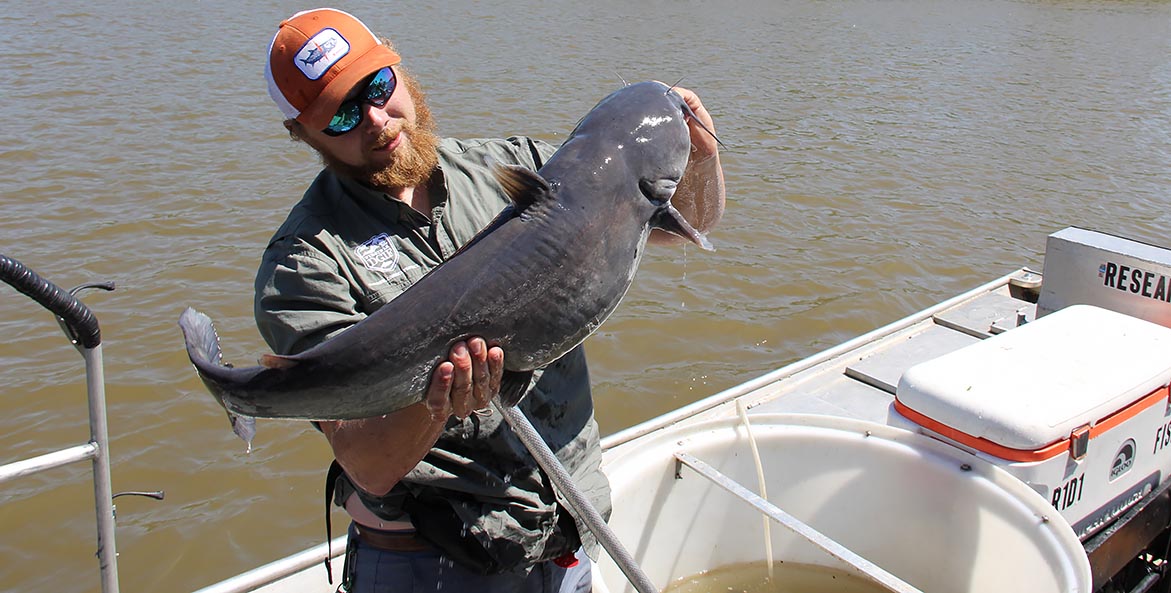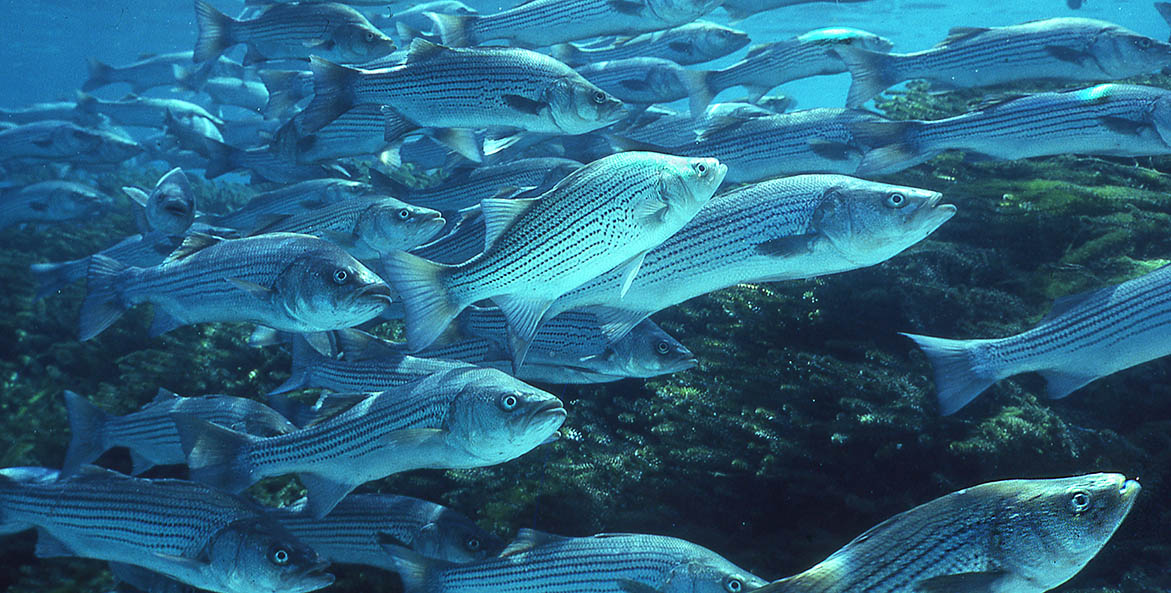Signs increasingly indicate that something is not quite right for striped bass, one of the most revered fish in the Chesapeake Bay and along the Atlantic Coast. In this in-depth series, we examine how a potent mix of fishing pressure, invasive predators, changing climate and habitat conditions, and disease is impacting the population—and what can be done to help.
Somewhere in the coastal waters between Delaware and the Virginia Capes, big striped bass are stirring. Over the next two months, many of these fish, most close to a decade old and over two-and-a-half feet long, will make a daring journey back to the upstream reaches of the tidal Chesapeake Bay rivers where they were born.
Here, they will bide their time until temperature conditions are just right in the warming spring waters. Then they will spawn, a 20-pound female capable of casting well over a million eggs into the current as males fight to get into the fray.
It is this crucial moment that begins life for one of the most revered fish on the Atlantic Coast. Increasingly, though, signs indicate something is not quite right. Last year, annual surveys in Maryland and Virginia that track young striped bass in the Bay found numbers well below-average, marking five years of poor reproduction in the Chesapeake. This recruitment failure is daunting as the Chesapeake is the spawning ground for upwards of 70 percent of the striped bass that eventually migrate along the Atlantic Coast. The news came amid other worrying indicators, including a persistently low number of large female striped bass since 2005 and a spike in recreational fishing in 2022 that, although not documented, likely happened in 2021 as well.
A potent mix of fishing pressure, invasive predators, changing climate and habitat conditions, and disease means fewer young fish will grow large enough to ever make it out of the Bay—and fewer still will survive the gauntlet of challenges long enough to one day return and successfully reproduce.
“It’s a dicey proposition,” says Dave Secor, Professor of Fisheries Science at the University of Maryland Center for Environmental Science's Chesapeake Biological Laboratory. “In an average year, a female can’t replace herself and her mate, which is the objective for persisting as a population.”
The good part of this story is that striped bass are resilient. We just have to give them the equipment to succeed.
The combination forced the Atlantic States Marine Fisheries Commission (ASMFC), the body that manages striped bass fisheries coastwide, to enact regulations that tightened the size and number of fish anglers can keep and reduced quotas for commercial fleets. In January, it voted to make emergency measures permanent in order to support a plan to rebuild the population by 2029.
In February, Maryland approved its own emergency regulations that prohibit recreational fishing targeting striped bass between April 1 and May 15, which eliminates the state’s trophy season. The regulations also prohibit targeting striped bass in the Susquehanna Flats, at the mouth of the Susquehanna River, through the end of May.
What’s Going On?
The situation isn’t yet as dire as the early 1980s, when the striped bass population crashed and managers issued moratoria on fishing. However, the problems facing striped bass now may run deeper, with different stressors hammering the fish at every point in their life, say Chris Moore and Allison Colden, fisheries experts and CBF’s Executive Directors in Virginia and Maryland, respectively.
“There is just no gas left in the tank for these fish right now,” says Moore.
Pressures mount as soon as the fish hatch. For example, a study published in 2020 found that warmer, drier winters can reduce the likelihood that striped bass larvae will have access to an abundance of their favored food—the tiny, animal zooplankton called copepods—at the time they start feeding.
“There are of course other factors that influence how many [striped bass] are surviving from year to year, but the study suggests cold winters can help increase the likelihood that there is going to be good recruitment. It starts things off on the right foot,” says Nicole Millette, Assistant Professor at the Virginia Institute of Marine Science and the study’s lead author. “If you have warm winters, it sets things off on the wrong foot.”
It also hints that climate change could make things harder for striped bass.
Assuming they can get enough to eat, young striped bass are then faced with another problem: how to avoid becoming food themselves. Blue catfish, an invasive species, prey on young striped bass and are now the Bay’s dominant fish-eating predator, says Secor.

A member of the Virginia Department of Game and Inland Fisheries holds aloft a large blue catfish caught during an electrofishing demonstration in the tidal James River.
Kenny Fletcher/CBF Staff
“There are millions of blue catfish in each major tributary now, and they’re highly concentrated in the same nursery habitats that striped bass depend on,” he says.
If they can escape marauding catfish and other dangers long enough, striped bass can eventually grow large enough to make it out of the Bay and join the coastal migratory population. However, that can take nearly a decade. In the meantime, they’re subject to multiple pressures simultaneously, especially in the summer, Secor explains.
The heat of increasingly warm summer waters wears down the fish, making them work harder at everything they do. They are then more susceptible to disease. Repeated catch-and-release by anglers adds even more stress.
“You get into this situation where the fish are barely scraping by in summer,” Secor says. “They can recover from disease, when the temperature abates and prey become available. But the third stress—fishing—it’s too much.”
Most striped bass that survive this crucible do eventually leave the Bay and join the population that migrates along the Atlantic coast when they grow large enough. Migration allows the fish to escape the pressures of the Bay—at least momentarily—but it’s not a total reprieve. One of the largest recreational marine fisheries in the country is waiting for them in their summer grounds off the shores of Massachusetts.
Unfortunately, fish born in 2015, one of the last good years for striped bass reproduction in the Bay, are now off the coast of New England in the summers and vulnerable to fishing, says Colden.
“What they are seeing up there is masking the reality of what is going on and what is to come,” she says.
What Does the Future Hold?
If all this sounds dismal, the silver lining may be striped bass themselves. They are incredibly vigorous fish, can migrate long distances to find food and optimal conditions, and are capable of living long lives and producing huge quantities of eggs—if given the chance.
"The good part of this story is that striped bass are resilient," Secor says. "We just have to give them the equipment to succeed."
The most immediate fix is reducing fishing pressure, which in turn will help more fish grow big enough and live long enough to reproduce themselves.
Individuals can do their part by avoiding fishing for striped bass, especially in the hot summer months, say Colden and Moore. Instead, they recommend targeting other species like pickerel, perch, red drum, croaker, and mackerel. Fishing for invasive species, like blue catfish and snakeheads, is even better, and some charter boats are even beginning to offer trips specifically for these other fish.
“The Bay has an incredible number of species out there. Thinking about all the different things people can go catch in one day is really pretty phenomenal,” says Moore. “It might not be the species people think about or grew up catching, but there is still a tremendous bounty out there.”
Colden says reducing fishing mortality is really the only lever managers can pull in the short term.
However, actions to address all of the other stressors affecting striped bass are necessary, too.
In the medium term, that might include things like targeting water quality and habitat improvement projects to areas that have been identified as important spawning grounds for striped bass. Over the long term, actions to combat and build resilience to climate change are important to help ensure striped bass have enough to eat, enough oxygen in the water, and refuge from the heat.
Ultimately, it will take efforts not just here in the Chesapeake Bay region, but throughout the range of the Atlantic striped bass population. It’s part of what makes managing the fish such a challenging proposition, says Moore.
“This isn’t just a Chesapeake Bay problem,” he says. “There are issues up and down the Atlantic Coast. We really need to do a lot now, especially given the stressors like blue catfish and climate change. And we need to be proactive.”
Stay tuned in the coming months for our in-depth series examining the challenges confronting this iconic fish in the Bay and beyond.




